Gnats are a commonly found pest when growing orchids. It doesn’t even have to be orchids: just leave a cut grapefruit on the kitchen table overnight and in the morning, you’ll probably have a gnat or two hoovering above it.
Gnats are drawn to the moisture and humidity that the orchid provides, and if you haven’t had them yet, buckle up, buttercup, you’ll probably going to have them somewhere down the line.
Almost every orchid grower experiences gnats at least once.
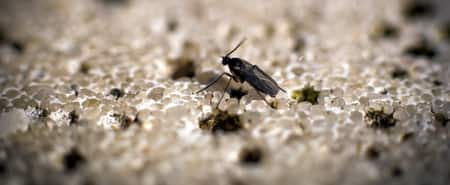
The good news is that the gnats in themselves won’t harm your orchid like other pests will. Adults might take a bite or two out of the leaves, but the biggest problem is that they exposed the open bite for viruses and other microorganisms to proliferate.
In this article, we’ll talk a little about who the gnat is, it’s life cycle, 10 methods to eliminate the gnats, and 4 ways to keep them gone for good. For the ten methods, we’ve divided them into 2 groups:
1) methods that will work eventually but will mostly fail, and 2) methods that are fail proof.
What Are Orchid Fungus Gnats
Fungus gnats are not the same as fruit flies, but copy them very closely. They are only seen as adults, since the other three stages of their life cycle are too small to visualize (1/16-1/8 inch long or 1.5-3.0 mm).
If you enlarge their picture, they look like miniature mosquitoes, with two antennae, long legs, and wings that are shaped like the letter Y .
There are several genera of gnats, some which bite, other which don’t. Orchid gnats don’t bite…well, at least not humans. As adults they can take little chunks out of orchid leaves, but nothing like other pests do.
They are extremely weak fliers, and slowly fly from one place to the other looking for moist soil to lay eggs. Their line of flight isn’t linear either, kind of bobbing up and down inconsistently. They are quite easy to kill when they are flying—which is great!
Will they hurt or harm the orchid? Not really…At most, they are an annoyance. But one thing that these fungus gnats do for the orchid grower is that they signal the potting medium is bad. When the eggs hatch into larvae, they prefer to feed on fungus that is nearby.
If they have found a great place to lay eggs, that means your potting medium isn’t draining out properly and the roots aren’t getting enough air circulation to dry out…and you probably have a fungal infection.
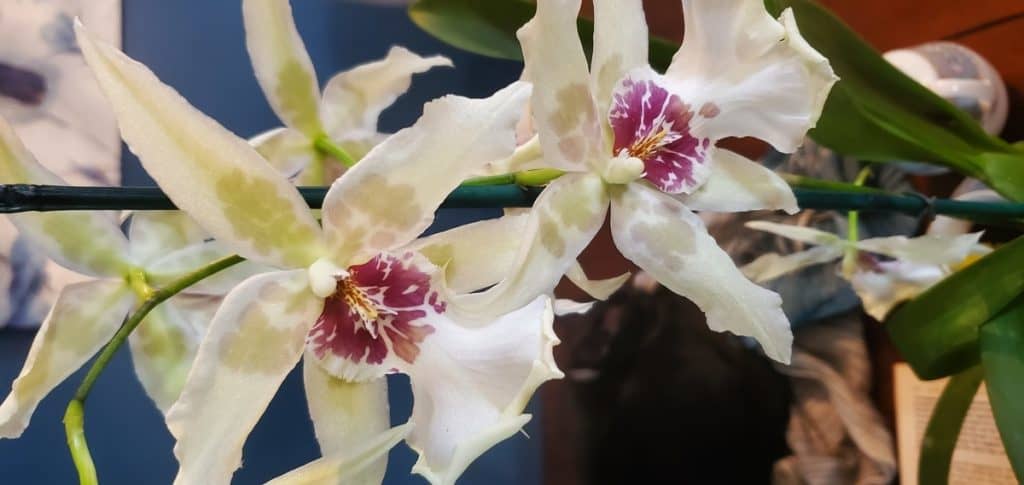
 There’s a popular saying referring to a canary in the coal mine. When the miners went underground to mine, sometimes lethal gases would leak from the air shafts. Since these odorless gases couldn’t be detected, they took caged canaries down with them. If the canary suddenly stopped singing and collapsed, it was a sign that a lethal gas was present, saving their lives. Gnats are the same. They are signaling that the potting medium is decayed, over-watered and probably over fertilized. For fungus gnats to be lurking above the moist media, then something is definitely wrong.
There’s a popular saying referring to a canary in the coal mine. When the miners went underground to mine, sometimes lethal gases would leak from the air shafts. Since these odorless gases couldn’t be detected, they took caged canaries down with them. If the canary suddenly stopped singing and collapsed, it was a sign that a lethal gas was present, saving their lives. Gnats are the same. They are signaling that the potting medium is decayed, over-watered and probably over fertilized. For fungus gnats to be lurking above the moist media, then something is definitely wrong.
Life Cycle of Fungus Gnats
Gnats grow from eggs, then develop into larvae. They feed on fungus, but that isn’t their only food preference. They can also eat rooting, decaying material, and live, fresh roots…so it might not a be a fungus that your orchid has, but root rot.
Bacteria causes root rot, but fungus feds on bacteria, and gnats fed on fungus… Technically, one leads to another.
The female adult will deposit anywhere from 30 to 200 eggs inside the potting media. These eggs aren’t black like the adults, but a whitish-pale or almost translucent color. They love to be in temperatures of around 75ᵒF (23ᵒC) which is what most of our orchids are when grown indoors.
The eggs take about 3 days to hatch, and will develop into pupae in 10 days. 4 days later, your adult is fully developed. 17 days after birth, these adults are ready to lay eggs.
As you can see, these are very quick to reproduce and if not treated, can quickly become a serious problem.
Why Are Gnats Attracted to Orchids?
The main reason that fungus gnats are attracted to orchids is the moist potting medium they are in. As mentioned above, fungus and moisture are on their list of places to rent. But they’re other items that attract gnats.
One is a decaying potting medium. Decaying material is usually soft enough and moist enough to provide the perfect place for eggs to develop into pupae. In a traditional potting medium setup, the sphagnum moss will break down over time and decay. Fir bark does the same (any bark, actually). Charcoal will also degrade, but at a lesser rate.
All these organic materials will decompose in time, and that is the main reason repotting needs to occur every two to three years. It’s also a great push towards semi-hydroponics and full hydroponics.
The other reason is too much fertilizer. Fertilizer is the number one decomposer of potting material, followed closely to over watering. Since the orchid naturally grows in conditions that nutrients and minerals are rare, and they catch what trickles down from the rain or what flows in on air currents, they are accustomed to living with less.
Too much fertilizer not only burns the roots, creates salt-build up residue on the top of the potting media, but also breaks down the organic compounds in the pot. The chemicals that aren’t used by the plant are absorbed by the sphagnum moss and bark. The overload slowly decomposes the sphagnum, accelerating the total useful “life” time that the potting media will be of any use.
The excess fertilizer is what the larvae need to become strong adults. Nothing like daily vitamins that are provided for free.
By the way, if you need some extra guidance about fertilizer, check out this page where you can download a 14-page fertilization guide for free. In this guide, I talk about Epsom Salt, Iron, Magnesium, dormancy cycles, and much more about fertilization. If you already know how to fertilize, then check out this page about 5 methods for fertilization and recommended products.
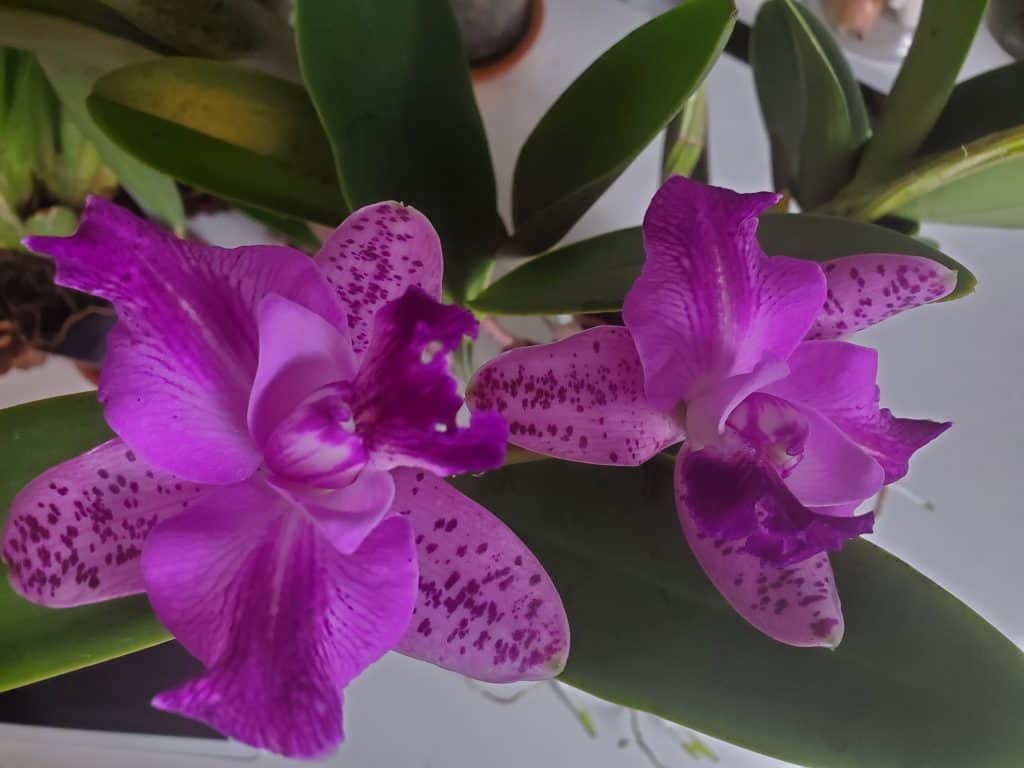
Treatments to Rid your Orchid of Gnats
Most methods that don’t work to treat gnats totally ignore the larvae and egg cycles.
These are the longest part of the gnat’s life. On the other hand, adult gnats don’t live long, so it’s counterproductive to try to eliminate them.
Some of the methods below work better than others, and it’s all about trial and error.
In my case, mostly error. But that’s the best learning method, right? Anyway, below are a few methods that did and didn’t work for me.
A) Tried, Tested, and Failed
Below are the methods I have found in several home and garden magazines. They worked somewhat…but mostly fail. Honestly, it really amazes me that these articles could have been published, especially when orchids are involved.
I’ll state first what they suggest doing, then I’ll state why it’s a horrible idea. Don;t get me wrong…These methods do “work”, but it will take months to get rid of a few gnats and your problem might become worse than better in that time.
1. Potato Rinds Attract Gnats out From the Potting Medium
Cut a potato into ½ inch slices and place a sliced potato in the potting media. Larvae will leave the fungus alone and head for the potato. Once they are there, you can take out the potato quickly, seal it in a plastic bag, and discard it.
Why this method doesn’t work for orchids: you’ll be supply extra food, but the potting medium is already rich in food, much more than a potato can provide.
Another downside: how many potatoes are we talking about? By the time the larvae can crawl out of the media, they will be half-way to adulthood. If you don’t seal the potato quickly, you’ve just made yourself a nursery for gnats.
2. Carnivorous Plants like Pinguicula plant (Butterwort) and Sundew
Now this is my favorite, despite being ineffective. 😊 Having carnivorous plants scattered throughout your orchid collection is the perfect way to attract unwanted guests.
They also take care of other little critters, which you can check out in this article. Some of the most famous plants that attract gnats are Butterworts (or pinguicula), Sundew, and Venus fly trap or other Drosera species.
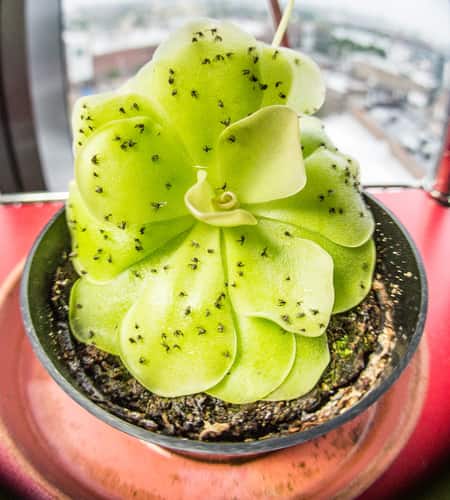
Why it doesn’t’ work:
Even though it’s my favorite method,
it also is the less effective.
You can squish a whole bunch of adult gnats
in the same time that one of these plants attracts, devours, and eliminates it. Since carnivorous plants only eliminate the adults and it takes eons to kill one gnat, this method doesn’t get as many stars on our rating. If the adult has already laid eggs in the potting media, then the whole idea of the carnivorous plant is useless.
Note: the Venus Fly Trap is NOT useful, since it only eats very few insects a month, and prefers larger ones, like big, black flies.
3. Fly Paper and Sticky Tapes Attract Orchid Gnats
Flypaper or sticky tape is less costly than the Venus Trap, mentioned above. These sticky yellow papers work wonders if you spread them around your plant shelf and by the windows.
Why it doesn’t work: For the same reasons as the others: they only trap the adults. Any eggs that were laid will still hatch.
4. Humidity Trays with Soap
If you use humidity trays, try adding some soap to the pebbles. Pour about 1/2 inch of apple cider vinegar, beer or fruit juice in the bottom of a disposable plastic cup. Stir in several drops of liquid dish soap, baby shampoo, or any cleaning liquid detergent that is mild.
Gnats are attracted to the humidity and the soap dish can lure them into the pebbles.
This also works with homemade water traps. Add apple cider vinegar to a little beer, and sprinkle a few drops of liquid soap to the mixture. Wrap plastic wrap around the top, securing it with an elastic rubber band. Poke a few holes in the top and spread these throughout your orchid shelf.
If you want to speed up the process, you can place a small part of ripe fruit in the container, which attracts more gnats into the trap. This works especially well for fruit flies, but fungus gnats also go after the bait.
Why it doesn’t work: it only attracts the adults.
5. Wheat and Soil Pots
Some growers have more elaborate traps, which consist of shallow pots of plain planting soil with wheat. These pots are scattered in between the orchid shelf.
Gnats, attracted to the smell of the fermenting wheat, will be tempted to lay their eggs in this pot. You then change out the soil every other day.
The downside of this method is that if you’re not careful, instead of eliminating the gnats, you just multiplied them. Just wait a few hours too long, and the eggs hatch, the pupae develop, and adults fly off free from your dysfunctional trap.
6. Yellow Traps with Petroleum Jelly (Vaseline)
You can make your own fly traps and gnat traps with yellow paper, a popsicle stick, and petroleum jelly. For some unscientific reason, gnats are attracted to the color yellow. You can use a yellow sharpie and paint a popsicle, cover it with Vaseline or petroleum jelly, and stick it into the medium.
The petroleum jelly weighs on their wings and they can’t fly away. This is a good child-project, something to do with your kids on rainy day and everyone is bored. 0
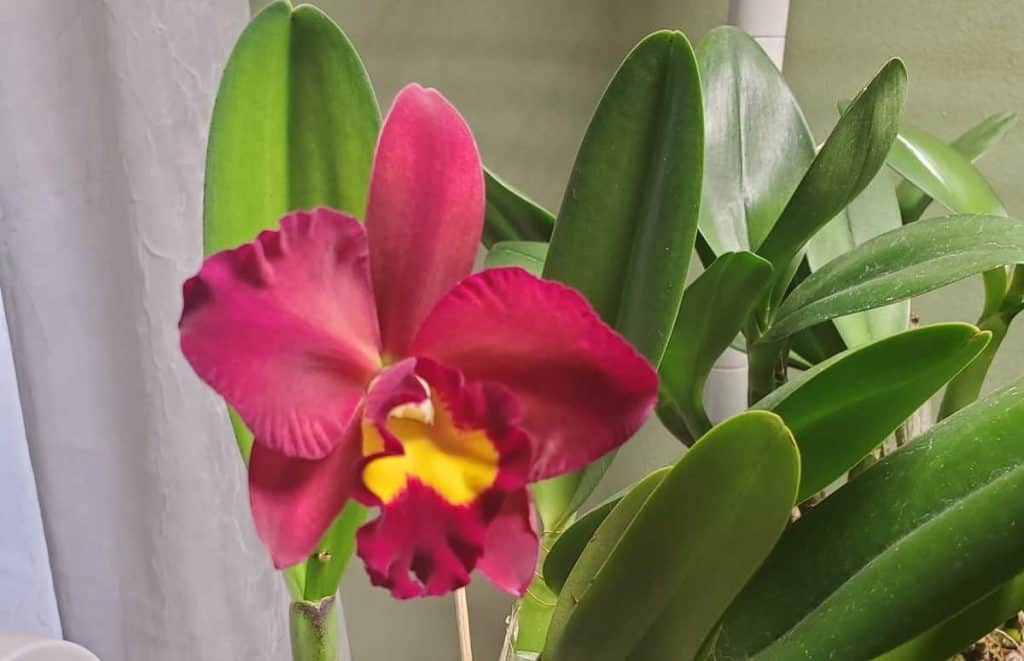
Why it doesn’t work:
This, again, only kills the adults. Don’t expect long-lasting results. These methods ignore the pupae or eggs. The adults only live a short period, and they probably have already infested the eggs in the potting media before these methods work… So no stars for this one.
7. Layers of Sand or Gravel
One magazine suggests adding a layer of gravel to the top of media. Since the eggs are laid close to the surface level of the potting medium, you can prevent them from
(1) entering the medium, or
(2) trap them inside once their there.
If you cover your orchid potting medium with sand, the adults can’t reach the media. It doesn’t have to be a thick layer, just one that is dry enough to prevent the humidity from accessing the roots.
Why this doesn’t work: For household plants that use potting soil, this is an excellent idea. The soil prevents the sand from leaking into the media. For orchids, well… The sand will penetrate the bark, sphagnum moss, and air holes, and to make a level layer of sand, you’ll have to drench your orchid.
Also, orchid pots are ventilated on the sides. The sand prevents the adults from leaving the top, but if your pot has huge holes on the sides for good ventilation, gnats could leave anytime they wanted through the backdoor.
How ALL these methods can work: If you have just a few gnats around, fly paper, sticky tape, humidity traps, carnivorous plants, wheat and soil pots, sand and gravel, yellow petroleum jelly sticks, and many others are useful, but only if you add another method as well. All these focus on the adults, so add another method that kills the larva and eggs. Then you aim for the whole four-part life cycle.
Better Methods of Eliminating Gnats
Now that you’re wondering what actually works, then here are our methods that we gave high ratings. 1) Mosquito Dunk: This method is probably the best method that can be used for most home growers, since the others involve more severe toxins and live critters.
In this method, you soak a tablet or pebbles in water overnight and water the pot as normal. The pellets contain Bacillus thuringiensis israelensis.
There are other Bacilius for sale, which is just a fancy word for bacteria, but make sure you purchase the kind that is Israelensis—specific to gnats.
You can find this method commercially known as Gnatrol™, and yes, it is actually a bacteria. The bacteria will wipe out the larvae inside the potting media. Again, Gnatrol can be sold to kill caterpillars and worms, too, so make sure you pick up the specific type for gnats.2) Insceticides: To kill the gnats, the only pesticides available are extremely toxic to humans and animals, and shouldn’t be used inside.
There are several names to look for, including: carbaryl, permethrin, imadichloprid, diazinon, malathion… Pyrethrin is an all-time favorite for eliminating gnats.3)Use of Parasites: Parasitic nematodes are small creatures from “the dark side” … sorry if this isn’t the technical term, but man… They’re gross. They infest the larvae’s digestive system, and while they feed on the host, they release their own bacteria in their excrement.
This bacterium literally kills the host very tragically. Talk about a good alien plot for a movie…
These little creatures can be sold under the commercial names as Steinernema carpocapsae, sold as ScanMask™, and Steinernema feltiae, sold as Nemasys™.
4)Use of Predatory mites: Hypoaspsis miles, a little critter who is especially good at his job, is applied over the potting medium.
From there, they dig into the pot, searching for live material to eat, and run across the fungus gnat eggs and pupae. Of all the live creatures you can buy online, these will last the longest.
How to Prevent Fungus Gnats from Returning
Now that you have properly eliminated the gnats from your orchid, you need to keep them away for good. Below are four methods to prevent the gnats from coming back.
1. Fans prevent Fungus Gnats from flying Orchid to Orchid
Since fungus gnats are week fliers, they can’t compete against a current. You should already be providing air circulation anyway. If you don’t have a fan on low running all the time, then you need to get one. Even with the setting on low, the air current is enough to not permit the gnat to land on your orchid.
2. Keep Your Potting Media Clean and Fungus Free
Make sure your potting media is clean, healthy, and new. Houseplants don’t need to be repotted as much as orchids do, and many new hobbyists make the mistake to keep their orchid in the same media for way too long.
3. Don’t Overwater
If the gnats have found moisture, then the roots aren’t being allowed to drain and dry out as much as they should be. Some orchids prefer to have a more humid potting media, growing by rivers, streams, and swampy areas. But the most commonly sold orchids, like Phalaenopsis, Cattleyas, Vandas and other orchids, need to have a time for drying out the roots.
If your roots system dries out, the gnats won’t like it. You can try to change your media or change your watering habits. Either way, try to adapt your methods to provide proper air circulation and less watering so your roots have plenty time and space to dry out.
4. Keep the Fertilizer to a Minimum
And the last point… Cut back on fertilizer. Sometimes we use so little fertilizer that it seems like it’s not even beneficial. Dilute the fertilizer as much as you can, and keep the fertilizer down to appropriate scheduling. I hope that with this guide you can eliminate your gnats altogether and keep your orchids safe. If you have tried any other methods, please comment in the section below and share your experiences.
Don’t Stop Learning!
If you want to be included in more information and get a 14-page fertilization guide, please sign up for my newsletter. I don’t spam, but send emails out bi-monthly with some curious topics of interest. If you want more information, click here to go to a specific page on this website where I explain it more in detail.

Also, if you are looking for an orchid journal to keep your notes specifically about orchid care, check out my 2 solutions for that on this page. If note-keeping isn’t your thing, then there is a free excel spreadsheet that you can download. Click here for more information on how to do that.
If you subscribe to my newsletter, I will send you a 14-page guide on the main tips of orchid fertilizer. It is downloadable and you can print it out on your computer. I designed the guide to double up as a coloring book, just to make it fun.
Happy Cultivating!


Greate article. Keep posting such kind of info on your blog.
Im really impressed by your site.
Hello there, You have done a great job. I’ll definitely digg
it and individually recommend to my friends. I’m confident they will be benefited from this website.
Thank you, Laurie! It’s so good to get some feed back! 🙂 Stay safe!
I really like all the points you have made here.
Hi, Marlyn! Thank you! I put a lot of work into the research and I’m glad it shows! I wish you all the best with your orchids. Since you’ve read this specific article, then I also wish you all the best with getting rid of those pesky gnats!